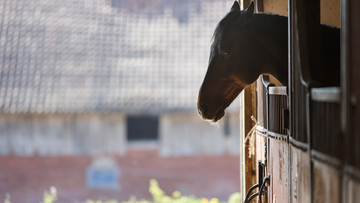Weaving is a common issue faced by horse owners and trainers, characterized by the repetitive, side-to-side swaying motion of a horse's head, neck, and body. This problematic behavior not only detracts from the horse's overall well-being but can also lead to physical complications and stress for the animal. Understanding the causes and viable prevention methods is essential for those who care for these majestic creatures.
Weaving in Horses: An Overview
 Weaving in horses is a common stable vice that involves the horse repetitively swaying its head and neck, shifting its weight from one front leg to another. This behavior may occur when a horse is confined to a stall for an extended period or when it experiences stress, boredom, or frustration.
Weaving in horses is a common stable vice that involves the horse repetitively swaying its head and neck, shifting its weight from one front leg to another. This behavior may occur when a horse is confined to a stall for an extended period or when it experiences stress, boredom, or frustration.
Weaving is not only detrimental to the horse's mental well-being but can also lead to physical issues. The repeated swaying motion can put significant strain on the horse's joints and ligaments, increasing the risk of injury and long-term wear and tear. It can also affect the horse's hoof balance, as the constant weight shifting can cause uneven wear on the hooves.
Causes of Weaving in Horses
Stable Environment Factors
Weaving in horses can be attributed to various environmental factors. Confinement in stalls for extended periods may trigger this behavior. Horses are naturally active animals, and restricting their movement can lead to stress and boredom, thereby causing them to develop stable vices like weaving. Stable design and size can also play a role – small and poorly ventilated stalls may increase anxiety and restlessness in horses.
Social and Mental Factors
Horses are social animals that thrive in herds with companions. Isolation can result in mental health issues, such as separation anxiety and increased stress levels. Social isolation and housing conditions lacking interaction with other horses may contribute to weaving behavior. Providing horses with pasture access or more social contact with their herd reduces the chances of developing weaving as a vice.
Dietary Factors
Dietary factors can also play a significant role in weaving behavior. Lack of forage in the diet can lead to feelings of hunger, resulting in anxiety and stress. To avoid weaving stemming from dietary factors, it's essential to ensure horses have continuous access to a balanced diet. Providing hay or a suitable forage replacement can alleviate boredom, reduce stress, and minimize the risk of weaving.
Recognizing Weaving Patterns
Physical Signs
Some of the physical signs to look for in a weaving horse include:
- Uneven hoof wear: The repeated shifting of body weight can cause wear in the hooves that appear uneven, especially on the front feet.
- Joint stress: Prolonged weaving may lead to joint stress, causing discomfort and swelling in the affected joints.
- Muscle imbalances: Weaving horses may display specific muscle imbalances due to the repetitive nature of the behavior, resulting in uneven muscle development.
Provide relief of physical tension with the Benefab Smart Poll Pad - easily attaches to your halter and/or bridle.
Behavioral Signs
In addition to the physical signs mentioned above, horses exhibiting weaving patterns may also display behavioral signs. These may include:
- Compulsive repetition: As a stereotypic behavior, weaving can be seen as a compulsive activity, with the repetitive shifting of body weight becoming an almost persistent routine.
- Isolation: Horses engaged in weaving patterns may become isolated from the rest of the herd, as the stereotypic behavior tends to consume their attention and lead them to focus solely on the repetitive motion.
- Anxiety: Weaving horses may exhibit signs of anxiety, such as restlessness or increased heart rate when prevented from performing the behavior.
- Increased weaving during stress: The weaving behavior may intensify during periods of stress, making it more apparent to observers. This can indicate that the horse is experiencing environmental or psychological discomfort.
Prevention and Treatment
Changes in Environment
Adjusting the horse's environment can help alleviate the symptoms of weaving. Consider adding windows to the stable to provide visual stimulation and allow the horse to observe the outside world. You can also provide them with other stimulation, such as toys or slow feeders.
Diet Alterations
To prevent and treat weaving, it is necessary to modify the horse's diet. Ensure the horse has sufficient forage to graze on, providing a natural source of nutrition. More frequent feedings and a continuous supply of hay or grass can help maintain the horse's satisfaction and reduce the likelihood of weaving due to frustration.
Physical Exercise Requirements
Regular exercise and activity are essential in managing a horse's tendency to weave. Providing ample turnout time in a paddock or arena will allow the horse to release energy and reduce stress. Implementing a consistent exercise routine, such as lunging or groundwork, will further help the horse's overall well-being.
Social Contact Modification
Horses are social creatures and require contact with their peers to maintain their mental health. Ensure that the horse has regular social contact with other horses, either by placing them in the same field or close enough to interact safely. Introducing the horse to different equine companions may help reduce weaving as the horse becomes more content and less anxious.






















